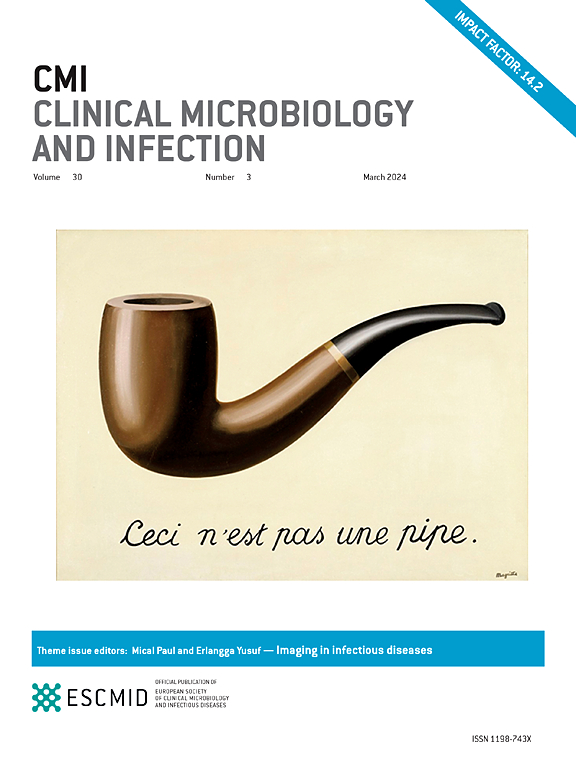法国老年人接种高剂量四价流感疫苗与接种标准剂量四价流感疫苗的相对效果:2021-22 年流感季节的回顾性队列研究。
IF 10.9
1区 医学
Q1 INFECTIOUS DISEASES
引用次数: 0
摘要
目标:高剂量四价流感疫苗(HD-QIV)作为标准剂量四价流感疫苗(SD-QIV)的替代疫苗,已于2021/22流感季节在法国引入,接种对象为年龄≥65岁的成年人。本研究旨在估算HD-QIV与SD-QIV对法国流感相关住院病例的相对疫苗效力(rVE):方法:从法国国家医疗保险数据库中选取年龄≥65岁、在2021/22流感季节接种过流感疫苗并报销费用的社区居民。从疫苗接种日到 2022 年 6 月 30 日、入住疗养院日或死亡日对这些人进行随访。根据前五年的医疗记录确定了基线社会人口和健康特征。从接种疫苗后14天到随访结束,记录了因流感和其他原因住院的情况。采用 1:4 倾向得分匹配法对 HD-QIV 和 SD-QIV 接种者进行匹配,并对年龄组、性别、接种周数和地区进行精确限制。采用零膨胀泊松或零膨胀负二项回归模型估算发病率比(IRR):我们将 405,385 名 HD-QIV 接种者与 1,621,540 名 SD-QIV 接种者进行了配对。与 SD-QIV 相比,HD-QIV 的流感住院率降低了 23.3%(95%CI:8.4-35.8)(69.5/100,000 人年 vs 90.5/100,000 人年)。配对后,我们观察到HD-QIV组的非特异性流感住院率和阴性对照结果率更高,这表明仍存在适应症干扰:结论:与 SD-QIV 相比,HD-QIV 与流感相关的住院率更低,这与现有证据一致,而法国的 SARS-CoV-2 流行率很高,HD-QIV 可能会优先用于老年人/合并症较多的人。本文章由计算机程序翻译,如有差异,请以英文原文为准。
The relative effectiveness of a high-dose quadrivalent influenza vaccine versus standard-dose quadrivalent influenza vaccines in older adults in France: a retrospective cohort study during the 2021–2022 influenza season
Objectives
High-dose quadrivalent influenza vaccine (HD-QIV) was introduced during the 2021/2022 influenza season in France for adults aged ≥65 years as an alternative to standard-dose quadrivalent influenza vaccine (SD-QIV). The aim of this study is to estimate the relative vaccine effectiveness of HD-QIV vs. SD-QIV against influenza-related hospitalizations in France.
Methods
Community-dwelling individuals aged ≥65 years with reimbursed influenza vaccine claims during the 2021/2022 influenza season were included in the French national health insurance database. Individuals were followed up from vaccination day to 30 June 2022, nursing home admission or death date. Baseline socio-demographic and health characteristics were identified from medical records over the five previous years. Hospitalizations for influenza and other causes were recorded from 14 days after vaccination until the end of follow-up. HD-QIV and SD-QIV vaccinees were matched using 1:4 propensity score matching with an exact constraint on age group, sex, week of vaccination, and region. Incidence rate ratios were estimated using zero-inflated Poisson or zero-inflated negative binomial regression models.
Results
We matched 405 385 HD-QIV to 1 621 540 SD-QIV vaccinees. HD-QIV was associated with a 23.3% (95% CI, 8.4–35.8) lower rate of influenza hospitalizations compared with SD-QIV (69.5/100 000 person years vs. 90.5/100 000 person years). Post-matching, we observed higher rates in the HD-QIV group for hospitalizations non-specific to influenza and negative control outcomes, suggesting residual confounding by indication.
Discussion
HD-QIV was associated with lower influenza-related hospitalization rates vs. SD-QIV, consistent with existing evidence, in the context of high SARS-CoV-2 circulation in France and likely prioritization of HD-QIV for older/more comorbid individuals.
求助全文
通过发布文献求助,成功后即可免费获取论文全文。
去求助
来源期刊
CiteScore
25.30
自引率
2.10%
发文量
441
审稿时长
2-4 weeks
期刊介绍:
Clinical Microbiology and Infection (CMI) is a monthly journal published by the European Society of Clinical Microbiology and Infectious Diseases. It focuses on peer-reviewed papers covering basic and applied research in microbiology, infectious diseases, virology, parasitology, immunology, and epidemiology as they relate to therapy and diagnostics.

 求助内容:
求助内容: 应助结果提醒方式:
应助结果提醒方式:


